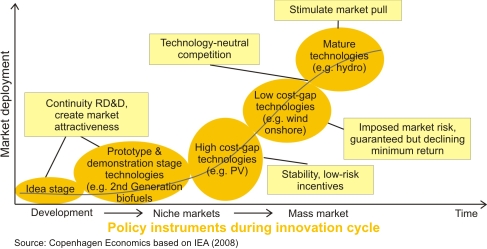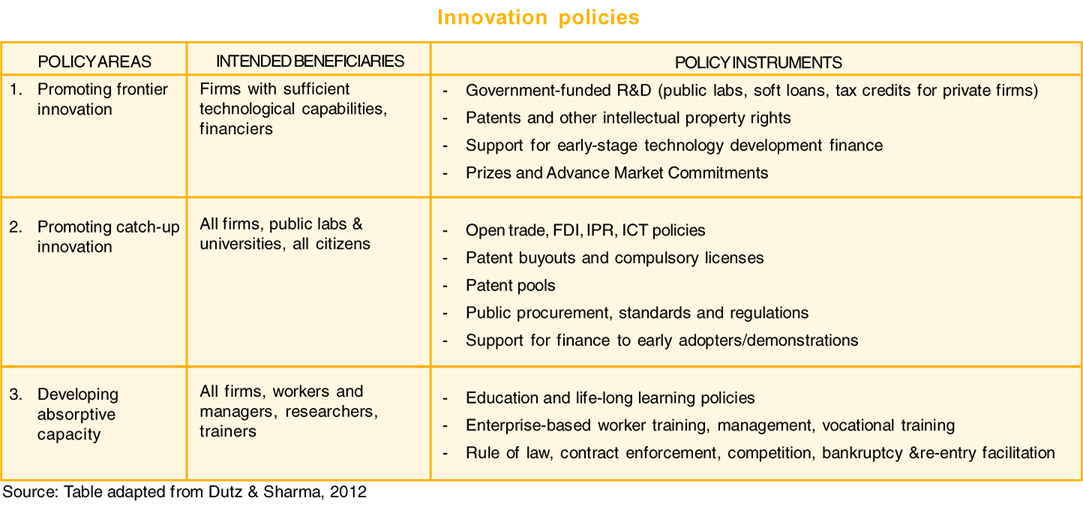|
Innovation as a Precursor to
Green Growth G reen Innovations can further be categorised into ‘frontier innovations’ i.e. new-to-the-world innovations and ‘catch-up innovations’ which comprise of diffusion (both across and within countries) and their adaptation to existing green products, processes, organisational and marketing technologies. Thus combining the understanding of innovation in the context of development and what is widely understood as ‘green’1, ‘green innovation’ can be defined as different ways that support and enable wealth creation and achieve more resource-efficient, clean and resilient growth. Examples of these range from technologies that improve energy efficiency, resource efficiency (e.g. Vertical Shaft Brick Kilns, hollow bricks), production processes (e.g., cement industry using municipal waste as a source of fuel, fly ash bricks), design and planning (e.g. urban land use design, industrial symbiosis) etc.As the above examples suggest, ‘green innovation’ can to a large extent influence the green growth agenda. Dutz and Sharma (2012), in their paper titled, ‘Green Growth, Technology and Innovation’ speak of a ‘double externality’, i.e., of knowledge-related market failures that have a compounding effect on the environmental externalities. To develop an understanding of the term ‘double externality’, it is first essential to identify the different mechanisms of innovation. These comprise of direct government funding for research and development (R&D) which includes funding of public labs and universities, grants, soft loans and R&D tax subsidies to private firms for early-stage, pre-commercialisation technology development. These are referred to as supply-push mechanisms that allow for coordinated research with little or no duplication.
The above mechanisms are suggestive of various R&D policy instruments as drivers of long-term innovation. However, these R&D policies applied on their own are said to result in ‘double externalities’. A classic externality problem in the production of knowledge, is that the benefits to society from the particular innovation, may exceed the private benefits from producing it (Schmidt, Hansen, Tops, Jensen, & Jespersen, 2010). Thus, what is evident is that the investments made are often not sufficient in comparison to the societal gains they create, which results in a ‘missing price’. While the ‘missing price’ refers to a negative externality, the benefits to the society as well as to the environment, refer to the positive externality or the positive spill-overs, thus the term double externality. Green Innovation and the Indian Green Growth Agenda Research has shown that a significant proportion of frontier green innovation takes place in high-income countries, with Japan, Germany and US accounting for 60 % of the total green innovation worldwide. Between 2000 and 2005, these majorly comprised of greenhouse gas mitigation technologies. Developing countries have a large capacity for catch-up green innovation through new-to-the firm adoption and adaptation of existing green technologies and through indigenous base-of-pyramid innovation (Dutz & Sharma, 2012). Base-of-pyramid innovations are defined as innovations to meet the needs of poor consumers. These innovations include formal innovations for the poor, primarily those by global and local private companies, public institutions, supported by public subsidies or produced through public-private partnerships. They also include informal innovations by local grassroots innovators which are based on improvisation and experimentation. These innovations aim at meeting the needs of poor households at affordable costs and at scale. Hence these innovations seek to create more products with less resources for a larger audience.
Thus both catch-up green innovation and base-of-pyramid innovation provide developing countries like India, who have lower technological capabilities to direct their green innovation policy agenda needs to take into account their local environmental needs, technological sophistication and implementation capabilities. A survey conducted on green base-of pyramid innovations by Dutz (2012) indicates that there continue to be very few green base-of-pyramid innovations that have been sufficiently scaled up. Further it is crucial to revisit the concept of double externality that suggests that that there is no single solution to solve both innovation and environmental challenges. Green innovation policies require to better understand both supply and demand side constraints, barriers to scaled-up commercialisation, identify the benefit-cost of particular policies and their implementation to improve market outcomes. It is often realised that a single innovation policy may lead to the rebound effect. That is to say that a single R&D policy could drive consumer demand towards supporting a technology that lowers the cost of energy used per unit, hence leading consumers to respond by increasing their level of energy consumption. This is called the rebound effect. Innovation policies in developing countries like in India, need to put in place policy instruments that are able to address the complementary knowledge and environment-related market failures. The optimal combination of policies include both an incentive to stimulate innovation towards influencing more sustainable growth (R&D subsidy that directs technical change towards cleaner technology) and a separate environmental incentive to internalise the pollution externality. This could be in the form of an emission tax or specific targets. Thus a combination of technology and environmental policies can facilitate the creation and diffusion of new environmentally-friendly technologies, while complementary policies ensure that the environmental externality is corrected through stronger incentives for their creation and adoption (Dutz & Sharma, 2012). Key Recommendations As is implied previously, the promotion of green growth for most developing countries is largely in the form of catch-up innovation and the diffusion of already existing technologies and lesser in the form of frontier innovation. While developing countries like India do not have the technological capabilities for the creation of frontier innovation, it can neither deny that fact that cost of not adopting, adapting and using existing green technologies can be high in terms of impeding a greener development pathway. Thus innovation policies in India should aim at ensuring removal of existing distortions and weaknesses in the business environment that hinders private innovation, especially through adoption of more open foreign trade, investment and technology licensing regimes, improve access to finance, strengthen skills and capacity development and implement greater demand-side policies like public procurement, regulations and standards. While there are numerous policy mixes that can enable diffusion and adoption of green technologies, the fact that remains is that there is lack of reliable data on the number of green base-of-pyramid innovations and the evaluation of the impact of these technologies in meeting the needs of the poor consumers. Thus, experimental evaluation with randomised controlled trials and quiz-experimental evaluation of existing technologies will require to be the first steps in identifying the appropriate mix of policies for a greener growth trajectory through the application of effective innovation policies. ■ Pratibha Ruth Caleb Endnotes 1 Referring to environmental sustainability References: |
 In contract to supply-push mechanism for innovation,
there are demand-pull mechanisms, for example patents and prize funds.
Patents are essentially decentralised self- selected mechanisms
where those involved believe that they are most likely to succeed and
thus risk their resources for the ‘prize of a period of exclusivity’
during which product prices are set and the disclosure of knowledge is
restricted to other researchers. On the other hand, a prize fund
refers to a pre-announced prize which is given to the creators of any
innovation that meets defined objectives. Prize funds are considered
most relevant mechanisms to promote technologies at the global level for
the needs of countries with lower technological capabilities and less
developed economies.
In contract to supply-push mechanism for innovation,
there are demand-pull mechanisms, for example patents and prize funds.
Patents are essentially decentralised self- selected mechanisms
where those involved believe that they are most likely to succeed and
thus risk their resources for the ‘prize of a period of exclusivity’
during which product prices are set and the disclosure of knowledge is
restricted to other researchers. On the other hand, a prize fund
refers to a pre-announced prize which is given to the creators of any
innovation that meets defined objectives. Prize funds are considered
most relevant mechanisms to promote technologies at the global level for
the needs of countries with lower technological capabilities and less
developed economies. 